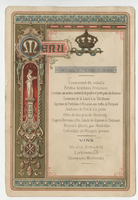Search the Special Collections and Archives Portal
Search Results

House of Savoy Royal Family residence, menu, February 25, 1884
Date
Archival Collection
Description
Text
Joan Olson Griffith oral history interview
Identifier
Abstract
Oral history interview with Joan Olson Griffith conducted by Sharee Schrader on April 12, 2005 for the History of Blue Diamond Village in Nevada Oral History Project. Griffith begins by discussing why she moved to Blue Diamond, Nevada with her family due to job opportunities at the Blue Diamond Plant, where they manufactured wallboard, in 1956. She describes life in Blue Diamond and rural Nevada, the education available in the village, and Blue Diamond's proximity to Bonnie Springs Ranch and structures made for the filming of Western themed media. Griffith concludes by discussing how Blue Diamond has changed since the 1950s and being a Sunday school teacher for eighteen years.
Archival Collection
Byrd Wall Sawyer Photograph Collection
Identifier
Abstract
The Byrd Wall Sawyer Photograph Collection contains color photographic slides depicting Byrd Wall Sawyer’s home, the Carson House, in Carson City, Nevada; towns and cities; and landscapes throughout Nevada between approximately 1950 to 1970. Nevada towns and cities primarily depicted include Belmont, Manhattan, Reno, and Dixie. Nevada landscapes include Carson River, Carson Mountains, Olinghouse Canyon, Washoe Lake, King’s Canyon, Lake Winnemucca, Washoe Valley, and Lake Tahoe.
Archival Collection
Harry Hayden Whiteley Photograph Collection
Identifier
Abstract
The Harry Hayden Whiteley Photograph Collection (approximately 1940-1967) contains photographic prints and one photographic negative depicting buildings, people, and project locations associated with the Las Vegas, Nevada architect Harry Hayden Whiteley. There is also one album containing photographs of contemporary churches compiled by Whiteley between 1953 to 1958.
Archival Collection
Anthony Kappenman oral history interview
Identifier
Abstract
Oral history interview with Anthony Kappenman conducted by Claytee D. White on May 16, 2019 for the Remembering 1 October Oral History Project. Kappenman begins the interview by talking about his early life, childhood, work, and his time in the military. Afterwards, he recalls what he did on October 1, 2017 prior to the Route 91 festival and during the shooting. He describes his journey trying to escape the area, arriving at the airport injured, and his stay in the hospital. Then, Kappenman talks about how he felt about the way the city and first responders had responded during the shooting, and how the community united afterwards. Lastly, he talks about his opinions on gun control, his recovery, and how he felt after the shooting.
Archival Collection
Russ Morgan Music Manuscripts
Identifier
Abstract
The Russ Morgan Music Manuscripts (approximately 1950-1967) are comprised of manuscript arrangements used by the Russ Morgan Band for live concert, radio, and television performances. The collection includes handwritten scores and parts for popular music.
Archival Collection
Joyce Bush oral history interview
Identifier
Abstract
Oral history interview with Joyce Bush conducted by Claytee D. White on September 20, 1995 for the UNLV University Libraries Oral History Collection. In this interview, Bush discusses the formation of her non-profit organization, International Youth for Christ Choir. She explains that she developed the idea in 1994, based on the "True Love Waits" abstinence program of the Baptist Church. She explains how the organization was formed, the process of building a board of directors, ideas about fundraising, publicity, and soliciting donations, attracting youth to the organization, her hopes for the future of the organization, and the reasons corporate sponsorship was unlikely because they tend not to support religious groups.
Archival Collection
Delon Potter oral history interview
Identifier
Abstract
Oral history interview with Delon Potter conducted by Eleanor Christoffersen on February 3, 1972 for the Ralph Roske Oral History Project on Early Las Vegas. In this brief interview, Potter, a Mesquite, Nevada native, talks about his birth in 1909 and his move to Las Vegas in 1933. He describes the early town and some of the more notable inhabitants including "Pop" Squires, working at the Winterwood Ranch at the base of Sunrise Mountain, as a sheep herder near Kaolin, Nevada, and later as a construction worker at the Hoover Dam. After the war, Potter explains that he tried running his own ranch in Utah before moving back to Henderson, Nevada, working for U. S. Lime and trading horses throughout Nevada, Utah, and Arizona.
Archival Collection
Richard D. Chase oral history interview
Identifier
Abstract
Oral history interview with Richard D. Chase conducted by Helen Rondthaler on October 17, 1972 for the Ralph Roske Oral History Project on Early Las Vegas. Chase discusses the history of Las Vegas, Nevada from 1945, touching on topics such as the housing shortage during the 1940s, The Red Rooster swingers’ club, Billy Moore, Sam Larson, Ira Goldring, atomic bomb testing, and the Nevada environment. Chase discusses the importance of construction-based labor to the development of Southern Nevada. Chase also explains at length the impact of the Nevada Test Site on his construction company.
Archival Collection
John West oral history interview
Identifier
Abstract
Oral history interview with John West conducted by Claytee D. White on August 10, 2000 for the Boyer Early Las Vegas Oral History Project. In this interview, West discusses his family background and arriving to Las Vegas, Nevada in 1954. West describes his educational experiences in Las Vegas and his career as a clinical psychologist. He recalls his father’s career in medicine and becoming the first African American licensed medical doctor in Las Vegas. West then talks about attending entertainment events before race integration was introduced, and the voting patterns in West Las Vegas. Lastly, West discusses his father’s decision to remain living in West Las Vegas and operating his medical office there after integration.
Archival Collection
